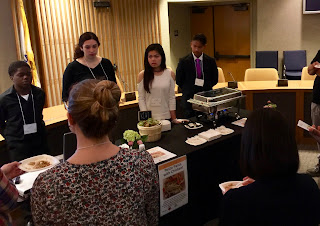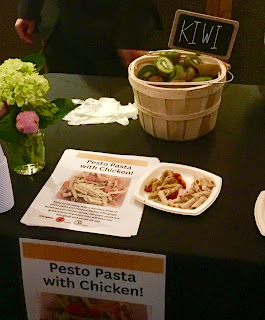 |
| Students present their ideas for school food at the "Let's Eat" event on May 25. |
On Friday evenings for the past semester, a group of San Francisco Unified School District (SFUSD) high school students have collaborated with Student Nutrition Services to reimagine and provoke system-wide change within SFUSD's food system.
The School Food Advisory (SFA), led by Juri Sanchez and Henry O'Connell at Student Nutrition Services, is a group of 12 high school students from 5 schools. The students were tasked with the challenge, “How might we design an inclusive dining experience where high school students feel represented and look forward to enjoying a meal at school?”
Throughout the semester, the SFA utilized the five step human-centered design thinking process: empathize, define, ideate, prototype and test to engage with their school community and develop innovative design concepts.
On Friday, May 25, students presented their design concepts at “Let’s Eat!”, an event hosted in the Board of Education chambers for students, families, teachers and district administrators. Students explained how they designed new menu items based on three general concepts: larger portion sizes, vegan alternatives and more culturally diverse options.
All ideas followed the USDA nutritional guidelines, SFUSD Wellness Policy, and a budget of $2.50 for the food to tackle their design challenge. Students discussed the importance of seeing their concepts incorporated into their school menus.
 |
| A sample meal that students helped to develop. |
One concept, “The Veganning to Something New,” included providing vegan meal and drink options for students. “I felt very passionate about this concept because it was important for me to bring my vegan and lactose intolerant peers a meal that will include them in the school lunch experience,” said Samantha Lavan, a Lowell High student who participated in that group suggestion. “It was also very important to me because, as an environmentalist, I was also very passionate about thinking about the environmental effects of the food we put on our plates.”
Lincoln High student Harrison Lee worked on a different concept, “Operation Eat,” to ensure all students feel satisfied and full with the dining experience at school. “Operation Eat” utilized inexpensive and satiating ingredients to create a Chicken Pesto Pasta and Rogeli Alfredo Pasta recipe that are satisfying and filling.
“Students don't get enough to eat at school, which caused my friends to eat elsewhere during lunch,” Harrison said. “I believe ‘Operation Eat’ is important because students should not all receive the same meal. Some students are tall and weigh more, causing them to require more calories than their peers.”
Laney Chen, a Washington High student, also found that some students need more food than others. “I decided that the meal portions were not enough to satisfy hungry students who may only have school lunch as their only source of food,” Laney said. “After receiving feedback from my classmates during the empathize process of design-thinking, I concluded that many students were unhappy with the sizing. SFUSD has many student athletes and the current portions are not enough to last them until dinner time, nevertheless practice for two hours after school. I wanted to ensure that everyone in the district had enough to eat.”
The third concept from students, “World Food,” calls for schools to provide culturally appropriate and diverse meals that taste like what students are familiar with. Students shared the demographics of SFUSD and pointed out that the school lunch doesn't represent the majority of them.
“Every culture deserves to be represented in the school lunch,” said Stephanie Lieu from Washington High School.
 | |
|
At the end of the presentation a panel discussion was moderated by Jack Calvin, a student from Mission High, where students engaged in a conversation about their experience on the School Food Advisory and the design-thinking journey.
Yaheli Garcia from John O’Connell said, “The School Food Advisory gave me the opportunity to provoke change and focus on solutions to improve the lunch."
The students will be able to utilize and translate the design-thinking process to life skills. Roger Moore from Mission High said, “Design thinking can be used to solve other societal issues such as housing, welfare, and homelessness.”
Students who are are interested in joining the School Food Advisory may contact SFUSD's Future Dining Experience Youth Engagement Coordinator, Juri Sanchez, at Sanchezj7@sfusd.edu.
Yaheli Garcia from John O’Connell said, “The School Food Advisory gave me the opportunity to provoke change and focus on solutions to improve the lunch."
The students will be able to utilize and translate the design-thinking process to life skills. Roger Moore from Mission High said, “Design thinking can be used to solve other societal issues such as housing, welfare, and homelessness.”
Students who are are interested in joining the School Food Advisory may contact SFUSD's Future Dining Experience Youth Engagement Coordinator, Juri Sanchez, at Sanchezj7@sfusd.edu.
Comments
Post a Comment